Jack Bouroudjian, for CME Group
AT A GLANCE
- Current tensions in the Indo-Pacific and Eastern Europe could impact commodity markets in 2022
- Geopolitical tensions in Europe and Asia are already beginning to exacerbate supply chain issues initially triggered by the pandemic
2022 is starting with several issues that could create serious volatility for traders in the months ahead. Aside from the supply chain problems and other economic disruptions caused by the pandemic, tensions triggered in the Indo-Pacific and Eastern Europe have added to growing uncertainty. The commodity markets are poised for potential price adjustments from the ancillary effects of these tensions.
The situation in the Indo-Pacific is a slowly developing story between China and Taiwan. With Taiwan one of the largest producers of semiconductors, any disruptions could produce shortages and serious supply chain issues for everyone using semiconductor chips. The Forex markets might also be a good proxy for these developing events. Moves in the yuan and yen could foretell possible problems.
The Ukrainian situation is a bit different in that there are two main markets which could be directly affected: grains and energy. Although Ukraine produces very little energy, 90 percent of pipelines going from Russia to continental Europe pass through Ukraine. According to BBC estimates, over 47 percent of the total energy imported by Western Europe comes directly from Russia via these pipelines. The markets have already begun to see the effects of measures taken by Moscow to control the flow of natural gas in the region, with costs now spiking in many European countries.

Source: Bloomberg Professional (CHRRDEP CNH and pre-2011 CNY)
The other main commodity produced in this region that could encounter supply chain disruptions is grains. Ukraine has always been known as the breadbasket of Europe. Aside from supplying the former Soviet Republics with a majority of their grain imports, at last estimates by the BBC, roughly 22 percent of grains imported by western Europe comes from Ukraine. Any conflict could disrupt the Ukraine exports and leave the Europeans looking toward the U.S. and South America for help.
Both the equity markets and fixed income markets usually react in a negative fashion when global tensions are heightened. Investors who are looking to protect themselves from the possible volatility caused by these geopolitical tensions can look toward traditional safe havens for capital preservation. While assets such as bitcoin have been thought of as an inflation hedge, the price action in crypto markets over the last couple years is more aligned with risk appetite than with safety. Over a period of centuries, gold has proven to be the market that investors look toward when worried about geopolitical problems.
2022 has already shown investors that it could be a pivotal year for all markets because of the ongoing pandemic and the geopolitical tensions we’re currently facing. Understanding which markets might be most affected could be the key to a profitable trading year.
Watch our full OpenMarkets Roundtable discussion on geopolitical risks above. Watch other episodes here.
Read more articles like this at OpenMarkets






